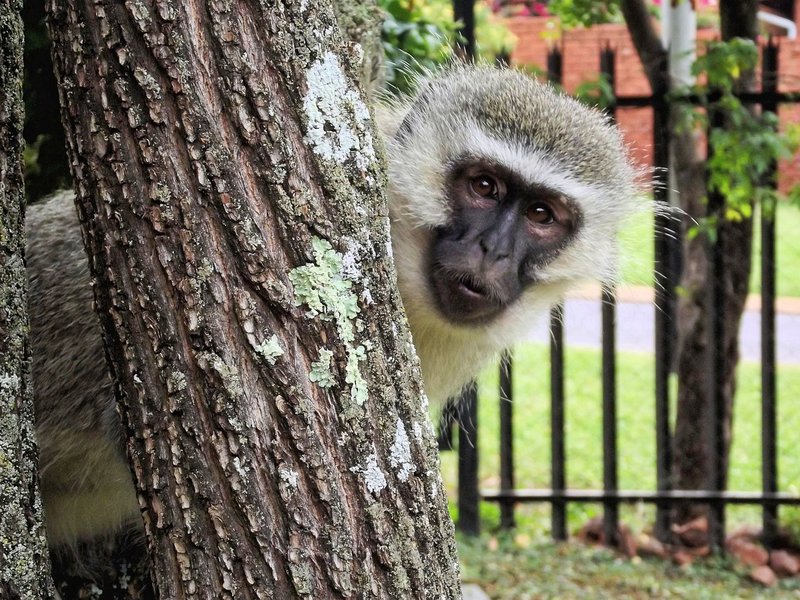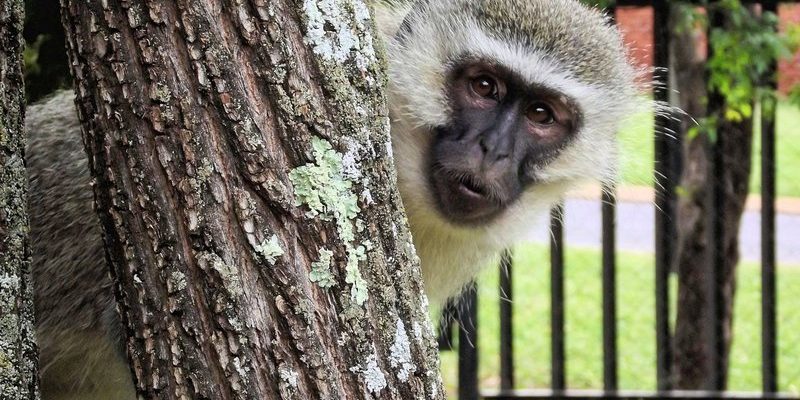
You might have seen videos of cute, playful monkeys swinging from trees, and among them, the Vervet Monkey stands out with its striking features and lively behavior. These small primates have captured the hearts of many with their expressive faces and social antics. Native to Africa, Vervet Monkeys are known for their agility and intelligence, making them a fascinating topic for anyone interested in wildlife.
Imagine sipping coffee in a sunny savanna while a troop of Vervet Monkeys playfully engages with one another nearby. Their playful nature and social structures make them not just interesting to watch but also vital to understanding broader ecological systems. In this article, we’ll explore everything from their habitat and diet to their social behaviors and interactions with humans.
Physical Characteristics
The Vervet Monkey is easily recognizable by its unique appearance. They are medium-sized primates, typically weighing between 8 to 13 pounds and measuring about 16 to 24 inches long, excluding the tail. Their fur is mostly grey, with a distinctive black face and white edges around the ears. The males usually have a slightly larger frame than the females, which is common in many primate species.
One of the most charming aspects of the Vervet Monkey is its expressive eyes, which can convey a range of emotions, from curiosity to playfulness. They also have long limbs that make them great climbers, allowing them to move swiftly through trees. Their tails, long and non-prehensile, serve as a balance aid while they navigate their arboreal homes.
When it comes to adaptations, Vervet Monkeys are quite remarkable. They have evolved to thrive in various environments, from savannas to woodlands. Their physical attributes allow them to escape predators like leopards or large birds of prey. This agility helps them maintain their role in the ecosystem as both prey and forager.
Habitat and Distribution
The natural habitat of the Vervet Monkey spans a wide range across sub-Saharan Africa. You can find them in open savannas, mountainous regions, and even urban areas. Their adaptability is one of the reasons they are prevalent in countries like South Africa, Kenya, and Uganda. They seem to enjoy areas with water sources and plenty of trees for climbing and foraging.
Vervet Monkeys prefer environments where they can easily find food and escape danger. They are often seen near human settlements, where they forage for scraps. However, living close to humans can lead to conflicts, as they sometimes raid gardens or steal food. This behavior might seem mischievous, but it shows their ability to adapt to changing environments.
Interestingly, they often return to the same sleeping trees every night, creating a routine that helps protect them. Having a stable nesting site provides safety from nocturnal predators. These sleeping sites are crucial for their social structure, as they groom and bond during the night, enhancing their relationships.
Diet and Feeding Habits
Vervet Monkeys are omnivorous, which means they eat a variety of foods. Their diet mainly consists of fruits, vegetables, seeds, and flowers. They also consume insects and small animals when the opportunity arises. This mixed diet allows them to adapt to seasonal changes in food availability.
During the dry season, when fruits become scarce, Vervet Monkeys have been seen foraging for roots and tubers. Interestingly, they are known to share food within their groups, showcasing their social nature. You might even catch them snatching a snack from one another’s hands, which adds to their playful charm.
Another fascinating aspect of their feeding habits is their foraging behavior. They often explore the ground for food and have been observed using tools, like sticks, to extract insects from tree bark. This behavior highlights their intelligence and problem-solving skills, making them more than just cute creatures but also clever foragers.
Social Structure and Behavior
Vervet Monkeys are highly social animals that live in troops usually ranging from 10 to 50 members. These troops have a strict social hierarchy, with clear dominance among members. Each monkey knows its place, which helps maintain order and reduces conflicts within the group.
Within the troop, grooming plays a vital role in social bonding and communication. Monkeys spend a significant amount of their day grooming one another, which not only keeps their fur clean but also strengthens relationships. It’s a bit like catching up with a friend while getting a manicure—essential for emotional well-being.
They communicate using a variety of vocalizations and body language. Different calls signal warnings about predators, food sources, or social interactions. For instance, they might use a specific alarm call to warn their troop about a looming threat, demonstrating their advanced communication skills.
Reproduction and Lifespan
The mating season for Vervet Monkeys usually occurs year-round, depending on the region. Females typically give birth to a single offspring after a gestation period of about 5 to 6 months. Newborns are particularly vulnerable, so mothers are very attentive, carrying their young everywhere until they are old enough to explore on their own.
Interestingly, male Vervet Monkeys often leave their natal troops upon reaching maturity, seeking new groups to join. This behavior helps prevent inbreeding and contributes to genetic diversity within populations. The bonding between mother and offspring is crucial, and you often see mothers grooming and caring for their young, teaching them the ropes of monkey life.
In the wild, Vervet Monkeys have a lifespan of around 12 to 15 years, but those living in captivity can live much longer. Their lives are filled with social interactions that keep them engaged and active, crucial for their mental stimulation and overall health.
Interactions with Humans
Vervet Monkeys have a complicated relationship with humans. On one hand, they often attract tourists and wildlife enthusiasts with their playful nature and social dynamics. You might find them stealing the show in national parks, where they are a popular sight. On the other hand, their adaptability to human environments can lead to conflicts, such as raiding crops or foraging in garbage.
In urban areas, they might become a nuisance, prompting some communities to take measures to keep them at bay. This can be a double-edged sword, as attempts to deter them can sometimes lead to misunderstandings and further conflicts. It’s important for humans living near these fascinating monkeys to find ways to coexist harmoniously.
Conservation efforts are vital because the Vervet Monkey’s habitat is threatened by human activities such as deforestation and urbanization. Promoting awareness about their ecological role can help foster respect for these creatures and ensure that they continue to thrive alongside humans.
Unique Facts About Vervet Monkeys
| Scientific Name: | Cercocebus pygerythrus |
| Weight: | 8 to 13 pounds |
| Length: | 16 to 24 inches |
| Lifespan: | 12 to 15 years (wild), up to 20 years (captivity) |
| Diet: | Fruits, seeds, insects, and vegetables |
| Social Structure: | Live in troops of 10 to 50 members |
Conservation Status
Currently, Vervet Monkeys are not listed as endangered, but their populations face threats from habitat destruction and hunting. Their adaptability to human environments has helped them survive, but that doesn’t lessen the importance of conserving their natural habitats. Preservation of their ecosystems is crucial for their survival in the wild.
Wildlife conservation organizations are working to protect these monkeys and their habitats. Initiatives often include educating local communities about the ecological importance of Vervet Monkeys. By promoting coexistence, these efforts aim to reduce human-wildlife conflicts while ensuring that the Vervet Monkey continues to thrive.
Supporting conservation initiatives can make a big difference. Even small actions, like spreading awareness about these charming monkeys, can contribute to their well-being. Together, we can ensure that future generations will also enjoy the playful antics of Vervet Monkeys.
FAQ
What are Vervet Monkeys known for?
Vervet Monkeys are known for their playful nature and social behaviors. They live in troops, communicate through various vocalizations, and engage in grooming, which strengthens social bonds within their community. Their striking appearance and intelligence make them popular among wildlife enthusiasts.
Are Vervet Monkeys aggressive?
Generally, Vervet Monkeys are not aggressive unless threatened. They tend to avoid confrontation and rely on their social structures to maintain order. However, they can become defensive if they feel their young are in danger or if their territory is encroached upon.
How can I help protect Vervet Monkeys?
You can help protect Vervet Monkeys by supporting wildlife conservation initiatives and educating others about their importance. Being mindful of your environmental impact, such as reducing waste and supporting sustainable practices, also contributes to their habitat preservation.
What do Vervet Monkeys eat in the wild?
In the wild, Vervet Monkeys have a diverse diet that includes fruits, vegetables, seeds, and insects. They are opportunistic feeders and will adapt to their food sources based on availability and the season.
Where do Vervet Monkeys sleep at night?
Vervet Monkeys sleep in trees to stay safe from nocturnal predators. They often return to the same sleeping trees each night, which provides stability and safety for the troop.
How long do Vervet Monkeys live?
In the wild, Vervet Monkeys typically have a lifespan of around 12 to 15 years. However, those in captivity can live much longer, sometimes reaching up to 20 years, due to better health care and protection from predators.
Can Vervet Monkeys be kept as pets?
Keeping Vervet Monkeys as pets is not recommended. They are wild animals with complex social needs that are difficult to satisfy in a home environment. Additionally, they require specialized care and can develop behavioral problems if not properly socialized.
Do Vervet Monkeys have any natural predators?
Yes, Vervet Monkeys face predation from various animals, including big cats like leopards and hyenas, as well as birds of prey. Their agility and social structure help them detect and evade these threats effectively.
Are there different species of Vervet Monkeys?
The Vervet Monkey is part of the *Chlorocebus* genus, which includes several species. These species share some common characteristics but can differ in size, color, and geographic range. Each species adapts to its environment in unique ways.
What is the social hierarchy like in Vervet Monkey troops?
Vervet Monkey troops have a clear social hierarchy, with dominant males typically leading. Each member knows its rank, which helps maintain order and reduces conflicts. Social interactions, such as grooming, play a critical role in reinforcing these relationships.

